Abstract
Raw Jojoba oil was used in a direct-injection diesel engine without any engine modifications and compared with both diesel fuel and 50/50 raw Jojoba/diesel. The measured parameters included the rheological properties measured in the range of shear rate from 100 to 500 1/s. Distillation data were presented for raw Jojoba oil compared to diesel. The parameters included exhaust gas analysis, block vibration, sound noise, and the combustion pressure and its rise rate. Averaged pressure-crank angle, vibration, and its frequency spectrum and sound level were presented. Data also included brake power, specific fuel consumption, and exhaust temperatures for all fuels used. For Jojoba oil, the engine did not exhibit low power output or specific fuel consumption. Exhaust temperatures, smoke opacity, and NOx emissions were lower than diesel case. Noise for Jojoba was higher than diesel case. The engine block vibration was concentrated towards the low frequency range.
1. Introduction
1.1. Use of Raw Neat Vegetable Oils
The use of neat vegetable oils in a diesel engines has been known since more than one-hundred years ago. With the anticipated reduction of the fossil fuels for diesel engines, the research efforts have been concentrated to find an alternative sources of energy to produce diesel-like fuels [1,2]. The use of neat vegetable oil has been investigated in several research articles. Examples for neat oils used as fuels for diesel engines are many, e.g., cottonseed oil [3], jatropha oil [4], palm oil [5], soybean and rapeseed oil [6], waste plastic oil [7], and lemongrass oil [8]. It has been shown that the ignition delay and maximum cylinder pressure did not change much for cottonseed oil compared to its biofuel [3]. The maximum pressure rise rate decreased for the neat cottonseed oil than its biofuel while the NOx emission decreased compared to the pure diesel case. For jatropha oil [4], its viscosity was highly reduced when mixed with diesel fuel. For 50/50 blend with diesel, the jatropha case did not exhibit lower thermal efficiency or operational difficulties. The thermal efficiency fell for the case of palm oil compared with the diesel case [5]. For oxygenated soybean and rapeseed oils [6], the thermal efficiency increased and the NOx emissions increased while the HC and CO emission decreased. Waste plastic oil [7] delivered diesel-like fuel consumption and increase in the thermal efficiency and reduced smoke and NOx. The use of neat lemongrass oil [8] in a diesel engine increased the NOx emission while decreasing the smoke. It increased the brake-specific fuel consumption and did not cause any operational difficulties. Sanli et al. [9] showed the importance of renewability and sustainability of any new fuel for diesel engines and compared the sustainability index of the fuel to that of diesel fuel. Sustainability is important for the fuel to have a clean, secure, affordable, and safe energy source [10,11].
1.2. Use of Jojoba Biodiesel
Raw Jojoba oil has been used to produce Jojoba biodiesel and has been used in diesel engines, either neat biodiesel or blended with pure diesel fuel. It has been shown that blending Jojoba biodiesel with diesel up to 20% improves the thermal efficiency of the engine and reduces smoke, CO, and HC while it slightly increases the NOx [12]. Modifying the combustion chamber part formed in the piston by adding more squish area in the piston causes a significant increase in the thermal efficiency and reduces the HC and CO [13]. It has been also reported [14] that adding only 10% Jojoba biodiesel to the diesel fuel causes the fuel to behave like the pure diesel; however, 10% Jojoba increased the HC and CO2 relative to diesel. Using Jojoba biodiesel did not increase the maximum combustion pressure or the combustion pressure rise rate [15]. Using Jojoba biodiesel as a pilot liquid fuel with the CNG or LPG used as the main fuel in dual fuel engine improved the performance and reduced the combustion noise and extended the knocking limits as well as reduced the cyclic variability of the combustion [16]. Using hydrogen as the main fuel in a dual fuel engine with Jojoba biodiesel as the liquid pilot fuel increased the NOx and smoke opacity emission [17].
1.3. Additves to Jojoba Biodiesel
Jojoba biodiesel can be used alone, or blended with raw Jojoba or pure diesel [18], with only the viscosity of raw Jojoba being higher than both biodiesel and pure diesel [19]. Some chemical additives have been tested before when added to Jojoba biodiesel to improve the properties, especially its high viscosity. Ethanol has been used in 10% additives and proved to improve the thermal efficiency and reduce the CO, HC, and NOx [20]. Adding up to 20% ethanol could result in decreasing the heating value [21]. Adding n-pentanol at 10% to Jojoba biodiesel improved the properties, and hence the thermal efficiency and reduced emissions of all CO, HC, CO2, NOx, and smoke [22]. Adding Diethyl Ether (DEE) at 15% appears to be a promising alternative additive with very low viscosity, which helped to reduce the viscosity of the Jojoba biodiesel greatly [23]. It reduced the ignition delay period greatly, increased the heat release rate, and increased the output power. Adding alcoholic additives like Heptanol at 10%–40% [24] to other biofuels like Jatropha biodiesel also resulted in increasing the thermal efficiency and reducing HC and CO, but increased the smoke level and NOx.
Nanoparticles derived from CuO in the range of 25 to 75 ppm added to 20% Jojoba biodiesel increased the thermal efficiency and reduced HC, CO, and smoke emission from the diesel engine [25]. Although CuO increased the viscosity and exhaust gas temperature, it decreased the fire point and the ignition delay period. Similar results have been obtained from Jojoba biodiesel added to nanoparticles made from Fe3O4 at 10–50 ppm [26]. This also improved the thermal efficiency and decreased the NOx, CO, HC and soot. In addition, this increased the viscosity and heating value while it caused the Cetane number to increase.
1.4. Use of Raw Jojoba Oil
Using raw Jojoba oil in diesel engines always is disadvantaged by its high viscosity [27] and low volatility. Adding 10% n-butanol to blend of diesel-raw Jojoba oil up to 35% raw Jojoba lowered its viscosity up to 85% compared with pure raw Jojoba oil. This increased the maximum combustion pressure and heat release rate, and reduced CO, HC, and NOx [28]. Adding as little as 5% raw Jojoba oil blended with 8% butanol greatly helped to improve the specific fuel consumption and brake thermal efficiency while lowering CO, HC, and increasing NOx. In addition, emulsifying this blend with up to 5% hydrogen peroxide (or water) decreased the NOx and exhaust gas temperatures [29]. Huzayyin et al. [30] suggested to add 40–60% raw Jojoba oil to diesel fuel to reasonably reduce the viscosity, improve the engine performance slightly, and reduce the NOx emission. Adding 20% raw Jojoba oil to diesel also resulted in a reduction of the Cetane number which reduced the NOx compared with the diesel engine case [31]. The total energy content of the Jojoba oil has shown to vary if a fertilizer is controlled to the Jojoba plant cultivation [32]. Using raw Jojoba at 60% with pure diesel fuel burned in a furnace helped to decrease NOx and HC. This was attributed to the oxygen content of the Jojoba oil [33].
It has been concluded here that some raw vegetable oils have been used as neat fuels in diesel engines. For Jojoba oil, it has been used only as a biodiesel derived by transesterification, but never used as raw oil in diesel engines. It has been also shown here that that biofuel has been used with some additives, e.g., alcohols, too. In addition, the raw Jojoba oil has been added to diesel fuel to create a blend.
1.5. Current Work Objectives
As mentioned above, the use of biofuel derived from Jojoba oil has been used before; however, the use of the raw Jojoba oil without any chemical treatment (or transesterification) in a diesel engine is missing. It is interesting to check if the raw Jojoba oil itself needs to be treated or if the engine would need some modifications in case of using the raw oil.
Hence, the objectives of the current work may be summarized to be the investigation of the possibility of using the raw Jojoba oil (or 50% mixed with diesel fuel) in a diesel engine without any modifications. In addition, we present some properties e.g., distillation and viscosity as compared with pure diesel fuel. It is also interesting to show how to optimize the fuel viscosity to suit the biodiesel fuel standard and the real diesel engine injection system. Then it will be interesting to present the engine performance parameters, e.g., thermal efficiency, power, block vibration, and external noise in addition to the exhaust emissions parameters as compared with the base case of pure diesel fuel. It may be envisaged that the use of the raw Jojoba oil in a diesel engine and the results of engine performance, vibration, noise, and exhaust emission are not available in the literature.
2. Materials and Methods
2.1. Engine Test Set-Up and Experimentation
The available engine used in the research is a Lister Petter direct injection diesel engine, with the specifications listed in Table 1. The engine speed was varied over the range of 1000 to 2700 rpm. The fuel injection pump rack position was varied for three positions: low load, medium load, and full load. The experimental data were collected for fixed rack position while the engine speed was changed in the specified range.

Table 1.
Specifications of the test engine.
The following parameters were measured: engine speed measured by a tachometer fixed to the generator, engine brake load measured by a load cell, and fuel flow rate measured by measuring the time to flow certain amount of fuel through the engine. The output brake power and brake specific fuel consumption can then be calculated. Exhaust gas analysis and gas temperature were measured by MRU Multi-Gas Analyzer, Vario Plus Industrial and the specifications are given in Table 2. The exhaust gas opacity was measured by AVL opacimeter. The combustion pressure was continuously measured by AVL piezoelectric pressure transducer coupled with Kistler charge amplifier and a data acquisition system linked with LabVIEW software that could collect the data at the rate of 10 kHz and store it in the computer for offline analyses. About five hundred combustion cycles of combustion pressures, vibration, and sound pressure level signals were collected at every running condition. Ensemble averaged signals’ cycles with respect to engine; four-stroke-pressure cycles were also calculated in MS Excel. It may be highlighted here that the noise was collected by two different sensors. One microphone sensor is a 7 mm in diameter microphone and has a dynamic range of up to 122 dB, 45 mV/Pa sensitivity, and 20 Hz to 20 kHz frequency range. The microphone was put inside a sound-absorbing acoustic shield to act as filter for minimizing unwanted background noise and reducing sound wave reflection for a more balanced recording of engine noise and was set at a distance of 1 m from the engine and 1 m above the ground according to SAE recommendations for microphone positioning. The microphone output was connected to a PCB signal conditioner and then connected to data acquisition card to record the cyclic detailed noise signals. The LabVIEW software was used to store the cyclic data of the detailed noise as a function of the time/crank angles. Another sound level meter was also used to obtain the average noise emitted from the engine and located at the same location. It has a measuring range of 30–130 dB and a frequency response of 31.5 Hz–8 kHz and this device was used to obtain average noise of the engine at different speeds and different blends. Both of these sensors are located inside an acoustic chamber which contains a sound-absorbing layer to prevent the measurements of the reflected sound waves. The maximum errors in the measured parameters are listed in Table 3. The fuels properties are shown in Table 4 as compared with pure diesel fuel.

Table 2.
MRU Multi-gas analyzer specifications.

Table 3.
Experimental uncertainties.

Table 4.
Properties of diesel and pure Jojoba oil bio-diesel.
2.2. Fuels
Viscosity of both raw Jojoba oil and pure diesel was measured under different temperatures and shear rates in a Fann 50SL Model Rheometer from Fann Instrument Company (Houston, Texas). Oil temperature was varied at 30, 50, 70, and 90 °C, while shear rate was varied at 50, 100, 200, and 500 1/s. The data are presented as dynamic viscosity at different shear rates or temperatures for both fuels. The Rheometer is controlled by its own software to set the pre-required temperature or shear rate in a software code. Distillation for both diesel and raw Jojoba fuels was carried out in a simple distillation rig made of a flask inserted and surrounded by a heater. The described unit is connected to a heat exchanger to condense the generated vapor into another flask. The blend ratio (raw Jojoba oil/diesel fuel) by volume was varied at 0%, 50%, and 100% with 0% representing pure diesel and 100% representing raw Jojoba oil. In the current work, the engine used different blends of diesel/raw Jojoba oil without any modifications. In addition, the Jojoba fuel used here was used without any esterification.
3. Results and Discussion
3.1. Fuels Properties
Figure 1 and Figure 2 illustrate the viscosity of both raw Jojoba oil and pure diesel fuel at different shear rates and temperatures. It may be seen from both figures that the viscosity at different shear rates from 100 to 500 for Jojoba oil was much higher than the pure diesel fuel; its viscosity was in the order of 33 mPa/s at 30 °C temperature at a low shear rate of 50 1/s and 30 mPa/s at a high shear rate of 500. This is compared to around 4.3 to 4.6 mPa/s for pure diesel fuel in the same range. The viscosity values for both diesel and Jojoba oil drops significantly at higher temperatures, see Figure 2, e.g., at low shear rate it drops from 33 to 24 when the Jojoba raw oil is heated from 30 to 90 °C. While, it drops from 30 to 8.7 mPa/s at shear rate of 500 1/s. These viscosity values are for pure Jojoba oil as produced from the cold pressing of the seeds and filtering the oil. However, for producing even a neat fuel for diesel engines, it is a necessity to add some chemical additives to improve the properties of such fuel. One of the important additives here to add is to reduce the viscosity of the oil while keeping or increasing its heating value and other physical/chemical properties that will make the Jojoba oil to be a favorable fuel for diesel engines without any further modifications to the fuel or the engine. It is important to highlight here that no additive was used in the current work and the viscosity was measured for the raw Jojoba oil without any additives added.

Figure 1.
Viscosities of raw Jojoba oil compared to diesel at four shear rates, at 30 °C.
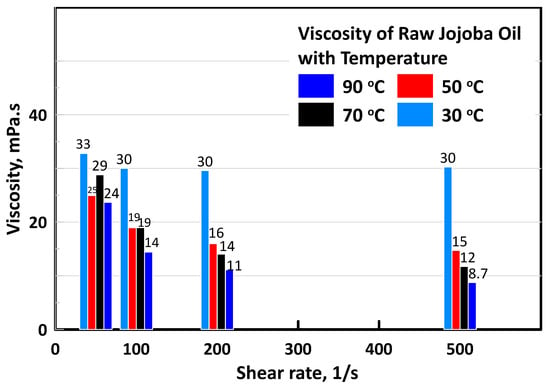
Figure 2.
Viscosities of raw Jojoba oil at different temperatures.
Figure 3 depicts the distillation data for both raw Jojoba oil and diesel fuel. It may be seen from the figure that the initial boiling temperature for diesel fuel was 240 °C while it was 324 °C for pure Jojoba oil; the final boiling temperature for diesel was 378 °C while it was 362 °C for pure Jojoba oil. It may also be noticed from the figure that the pure Jojoba oil started to boil at higher temperatures than diesel, but it boiled with a faster rate than diesel. In addition, it boiled completely at slightly lower temperatures than diesel fuel.
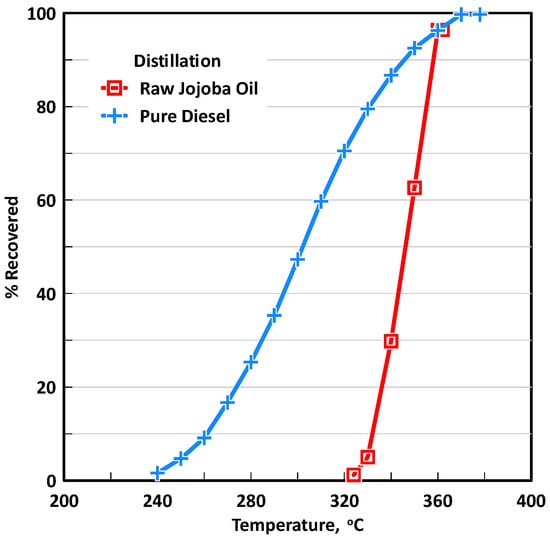
Figure 3.
Distillation of pure diesel fuel and raw Jojoba oil.
3.2. Engine Performance
Figure 4, Figure 5 and Figure 6 show the engine brake output power, brake specific fuel consumption, and exhaust gas temperatures at different engine speeds for the three fuels used, pure diesel, raw Jojoba oil, and 50% diesel/Jojoba blend. Figure 4 shows the performance curve of the diesel engine almost not affected by the type of the fuel used. Only at high speed of 1950 rpm did the engine start to produce slightly less power output compared with diesel. At all other lower speeds from 1200 until 1800, the power-speed curves were almost the same, if not slightly lower. It is important to emphasize here that the engine was not modified for the new fuels and it is still using the same injection equipment. Some diesel engines work at low speeds up to 2000 rpm, while others such as those for transportation, use higher speeds. It may be seen that the Jojoba fuel might suit diesel engines that runs at low speeds. For higher engine speeds, the Jojoba fuel properties might improve by mixing it with pure diesel fuel, e.g., 50/50 ratio or even lower, or with other additives.
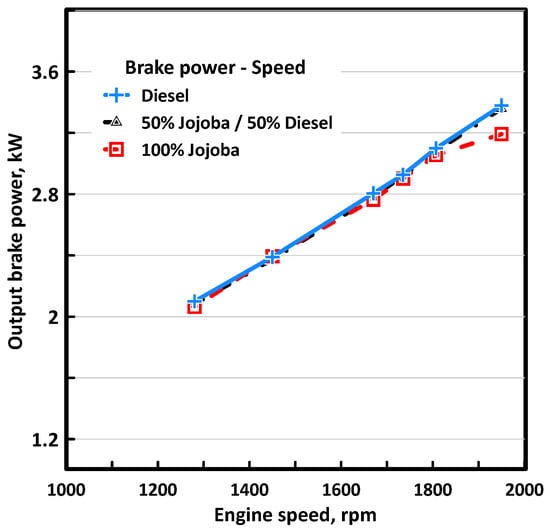
Figure 4.
Brake power output versus engine speed for diesel fuel and raw Jojoba oil.
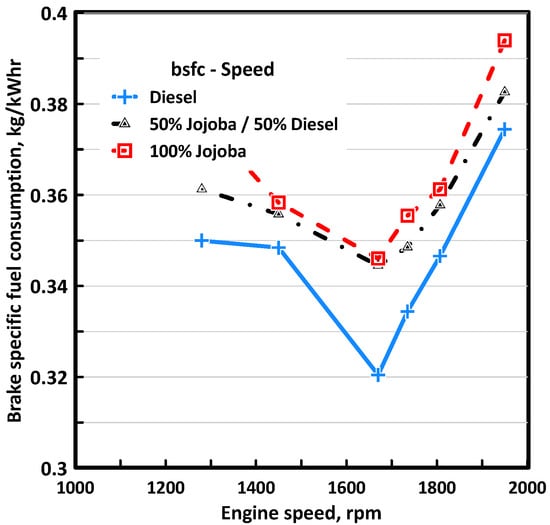
Figure 5.
Brake specific fuel consumption of pure diesel fuel, raw Jojoba oil, and 50/50 blend.
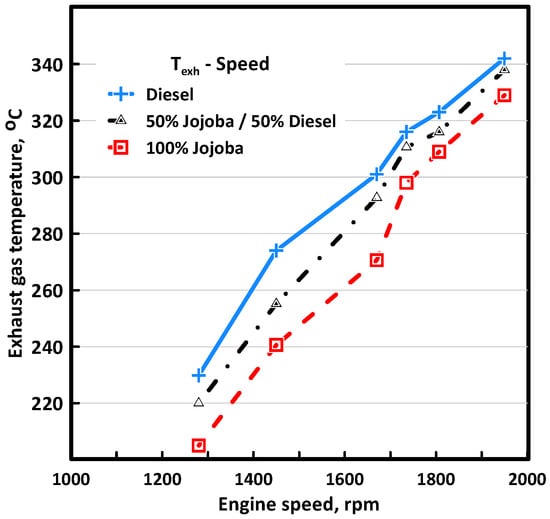
Figure 6.
Exhaust gas temperature of pure diesel fuel, raw Jojoba oil, and 50/50 blend.
This also has been shown in the bsfc-speed curve shown in Figure 5 where the bsfc values for pure Jojoba and its 50/50 blend were slightly higher than the values for the diesel fuel case. The minimum value for bsfc in the tested range of speeds was about 0.32 kg/kWh for diesel while it is about 0.345 kg/kWh for both Jojoba and its 50/50 blend with diesel. One can conclude that the powers-speed and bsfc-speed were almost not changed for the new Jojoba fuels.
Figure 6 illustrates the exhaust gas temperature against the engine speed for the three fuels. It may be seen from Figure 6 that the exhaust gas temperature for Jojoba fuel was slightly lower than the case for diesel fuel, e.g., at 1800 rpm engine speed, it was 323 °C for diesel fuel while it was about 310 °C for Jojoba case, which is 4% lower. This may be attributed to the slightly lower heating value of raw Jojoba oil as compared with diesel fuel; see Table 4.
3.3. Engine Exhaust Emissions
Hydrocarbon emissions HC, exhaust gas opacity, and Nitrogen Oxides emissions NOx against the engine speed are plotted in Figure 7, Figure 8 and Figure 9. The HC emissions for the three fuels at different engine speeds, as seen in Figure 7, show slightly higher HC for Jojoba than compared with the pure diesel case or 50/50 blend. For all fuels, increasing the engine speed reduced the emission of HC in the exhaust; this is expected due to the improvement of mixing the air and fuel which leads to faster and complete combustion and hence lower HC emissions. The raw Jojoba fuel produced more HC than the diesel fuel at all engine speeds; at 1800 rpm, the HC for diesel was 600 ppm while at the same speed for Jojoba the HC was about 1420 ppm. This increase in the HC for Jojoba may be attributed to the late evaporation of the liquid Jojoba oil, as depicted from its distillation curves discussed earlier. In addition, as the raw Jojoba fuel was used here without being esterified, the oil has different esters and components that will need more time to burn completely than the case for diesel fuel. Figure 8 shows the exhaust gas opacity (black smoke level) with the engine speed for the three fuels. It may be seen that the smoke opacity was slightly higher for Jojoba compared with the diesel fuel case. For all fuels, the opacity decreased with increasing the engine speed due to the improved fuel-air mixing and combustion that results in less unburned smoke components. NOx emission with engine speed is shown in Figure 9 for the three fuels used. It may be seen that the increase in the engine speed resulted in an increase in the NOx in the exhaust as mentioned earlier for improved mixing and combustion, which leads to higher combustion gases temperatures. However, the Jojoba fuel and its blend with diesel case produced less NOx emissions compared with the pure diesel case. As shown earlier in Figure 6, exhaust gas temperatures for the Jojoba fuel case were lower for Jojoba than for the diesel case. This might guide to the lower maximum combustion temperature—at the same engine speed—for Jojoba case compared with the diesel case. The reduced maximum combustion temperature for the Jojoba case might be one reason why the NOx emission in the exhaust is less for Jojoba fuel than for diesel. Another possible reason for the less NOx for the Jojoba case is that the Jojoba oil has some oxygen content and this might be the reason why the oxygen always dilutes the combustion gases and produces less NOx gases [30,33,34]. The emission of NOx for diesel at 1800 rpm was about 400 ppm while it was about 200 ppm for the Jojoba case, which is 50% lower. This would add to the advantages of Jojoba or Jojoba-derived fuels. Figure 9 also illustrates that even the 50/50 Jojoba/diesel blend offers mush less NOx emission than the pure diesel fuel case. If the Jojoba raw oil cannot be used due to its physical/chemical properties (e.g., high viscosity) then at least it may be blended with diesel fuel. Also, in addition, Jojoba oil is ten times lower than the Sulphur in the diesel fuel [31] and would not produce any sulfuric products in the combustion chamber or in the exhaust gases.
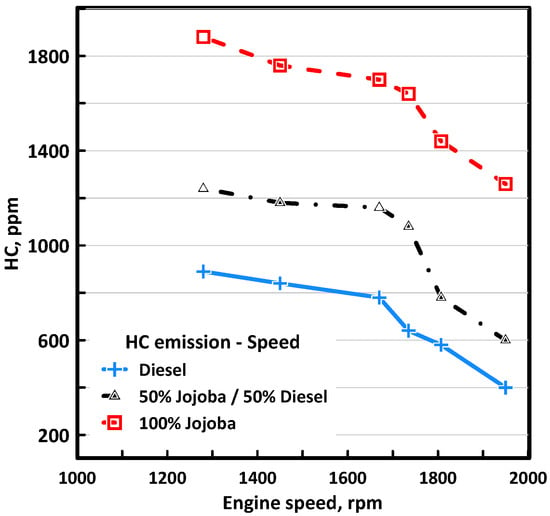
Figure 7.
HC emission of pure diesel fuel, raw Jojoba oil, and 50/50 blend.
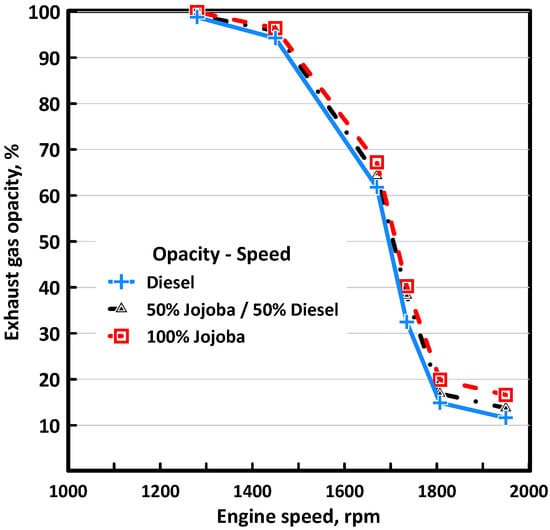
Figure 8.
Exhaust gas opacity of pure diesel fuel, raw Jojoba oil, and 50/50 blend.
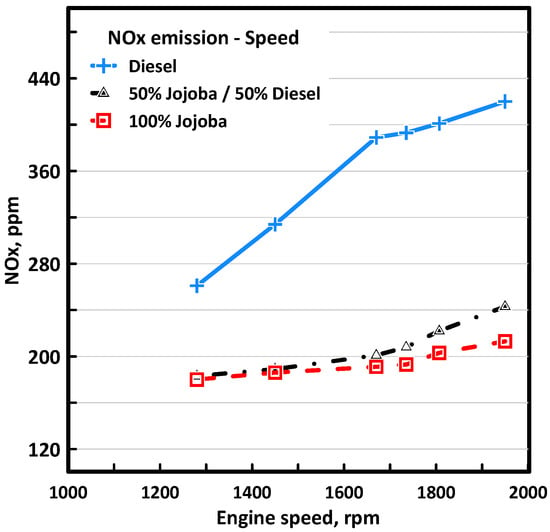
Figure 9.
NOx emission of pure diesel fuel, raw Jojoba oil, and 50/50 blend.
3.4. Engine Roughness, Vibration and Noise
Figure 10 illustrates a typical diagram for the combustion chamber pressure with the crank angle (or the time) and how the pressure rise rate is calculated. The value of the maximum combustion pressure rise rate, which normally occurs during the combustion duration, was taken as one of the engine roughness parameters. Figure 11 and Figure 12 show the variation of the maximum combustion pressure and its pressure rise rate at the tested engine speeds for the three fuels used. Figure 11 shows the maximum combustion pressure with the engine speeds and it seems it is slightly lower for Jojoba compared with the diesel fuel case, especially at low engine speeds. The maximum pressure rise shown in Figure 12 helps to explain the maximum pressure that occurs inside the combustion chamber for the fuels used. Increasing the engine speed reduces the maximum value of the pressure rise rate for all fuels used. This might be due to the improved mixing and increased cycle temperatures, which leads to reduce ignition delay period and faster self-ignition of the injected fuel. This reduces the pressure rise rate and produces smoother combustion and engine running. For the three tested fuels, it seems that the maximum pressure rise rate did not change much, although at low speeds, it looks slightly higher for Jojoba than the values for pure diesel. This is in line with the reduced exhaust gas temperature shown in Figure 6 as this reduced cycle temperatures tends to increase the delay period for ignition of the fuel injected and increase the rate of combustion.

Figure 10.
Typical combustion pressure and pressure rise rate (for Jojoba fuel, N = 1950 rpm).

Figure 11.
Effect of engine speed on the maximum combustion pressure for three fuels used.

Figure 12.
Effect of engine speed on the maximum combustion pressure rise rate for the three fuels used.
External noise and sound pressure level produced from the engine as measured by the two sensors used are shown in Figure 13 and Figure 14. Figure 13 shows the external noise as measured by the average noise meter with the engine speeds for the three fuels used. It may be seen from the figure that the Jojoba fuel case produced slightly higher external average noise at all engine speeds. This is followed by the 50/50 blend, and the diesel case produced the least noise. The difference between the noise for the Jojoba case and diesel case did not exceed 1 dB, as seen in the figure, which does not represent a big difference. One can conclude that using Jojoba fuel did not increase the noise much. It is well known that the external noise has three sources of mechanical noise of gears, shafts, valves, and other mechanical reciprocating and rotating parts. The second source of noise is the fluid mechanics noise due to the flow in the intake and exhaust ports as well as the flow of high-pressure fuel to the fuel injector as well as the flow behavior of the fuel. The third source for noise is from the combustion process itself as the high pressure rise rate converts to external noise and vibration of the engine block. The combustion noise appears to be higher for Jojoba, as shown in Figure 12, and the viscosity of Jojoba is much higher than that for diesel; viscosity, by definition, is the resistance to flow, which produces more resistance to flow on the injection pump and the high-pressure line, and this seems to produce more flow noise, assuming the mechanical sources of noise stay the same for the two fuels at the same engine speed. So, the external noise emitted from the engine as measured by the average noise meter appears to be higher for Jojoba oil than the case for the diesel fuel. This explains the trend in Figure 13 at all engine speeds. Figure 14 depicts the maximum noise as obtained from the ensemble averaged cycle of noise signal as collected from the microphone sensor over the many cycles collected. It may be also seen—similar to Figure 13 and except for the lowest speed tested—that the maximum noise generated was higher for Jojoba (compared with pure diesel) at most engine speeds tested. The values of the maximum noise found in Figure 14 are higher than the values obtained from Figure 13, as these represent the maximum noise detected over the complete engine cycle; it fluctuates during the same cycle.
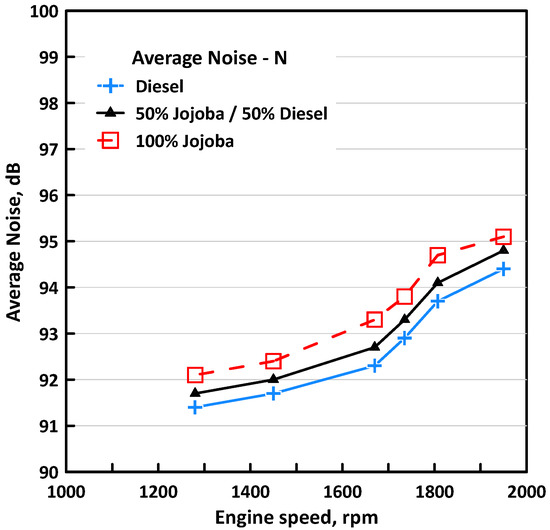
Figure 13.
Average noise measured by average noise meter.
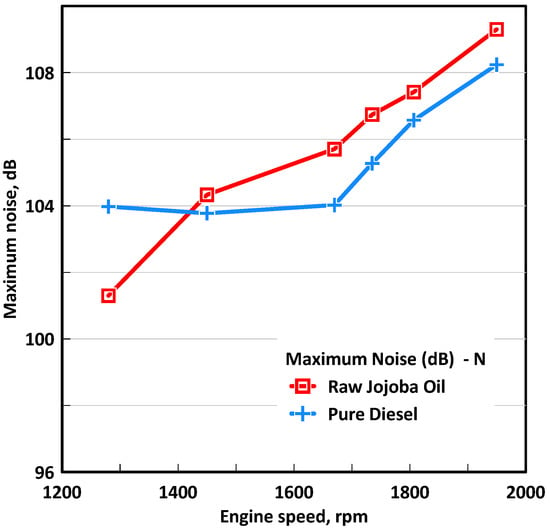
Figure 14.
Maximum noise amplitude for ensemble-averaged cycle measured by microphone sensor.
Figure 15, Figure 16 and Figure 17 illustrate the vibration behavior of the engine for Jojoba fuel as compared with pure diesel. Figure 15 shows the ensemble-averaged cycle for the five-hundred cycles collected for repeated engine cycles. The figure illustrates the time-domain data for two engine speeds of 1280 and 1950 rpm. Figure 16 shows the maximum vibration value at each engine speed for the ensemble-averaged cycle for the two fuels. It may be seen that the vibration produced for the Jojoba fuel was less than the vibration measured for diesel fuel case at all engine speeds. This seems to be good news for the Jojoba candidate. For example, at 1800 rpm engine speed, the maximum vibration magnitude for diesel fuel case was about 46.5 g while it was about 37 g for the Jojoba fuel case. These are the maximum vibration value recorded over the engine cycle. As seen in Figure 15, that the vibration signal has different peaks, e.g., one for maximum pressure rise rate associated with combustion process, one for intake valve opening/closure, and another for exhaust valve opening/closure. To explain the low vibration values in case of the Jojoba fuel case, Figure 17 shows the frequency domain of the vibration signal. It may be seen from Figure 17 that although the vibration signal for Jojoba case has higher amplitudes than the values for diesel case, the peaks (or more vibration energy) for Jojoba occurred at much lower frequency, i.e., the engine in that case would have been vibrating with less frequency of vibration (slower in motion) than the case of the pure diesel case. This may have been collected by the vibration sensor to produce lower vibration. It may be interesting also here to point out that the reduced vibration produced for the case of raw Jojoba may be due to the low maximum pressure measured in that case; check Figure 11 for the three cases of diesel, raw Jojoba, and 50/50 blend. The maximum pressure in the case of Jojoba is lower that that for diesel and this may be the reason why the vibration is lower.
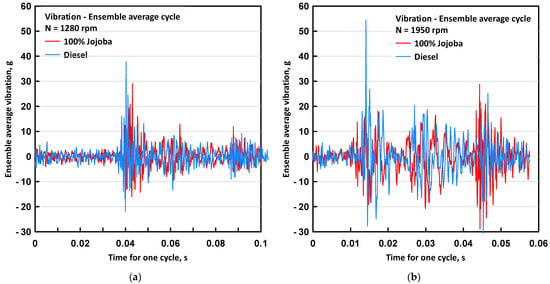
Figure 15.
Ensemble-averaged vibration cycle at two engine speeds of (a) 1280 rpm and (b) 1950 rpm for the two fuels used.
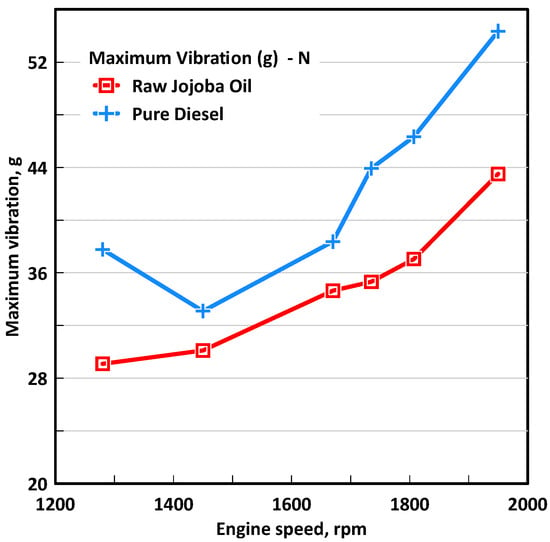
Figure 16.
Maximum vibration amplitude for the ensemble-averaged cycle.
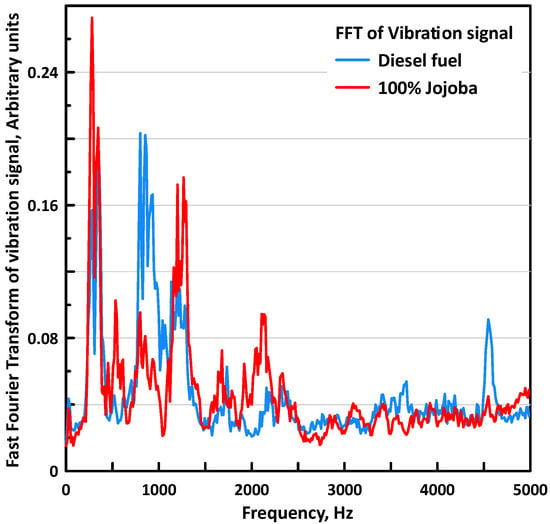
Figure 17.
FFT of vibration signal for the two fuels at N = 1950 rpms.
4. Conclusions
The experimental work carried out here reported the engine performance, exhaust emissions, block vibration, and external noise for direct injection diesel engine running on raw Jojoba as a fuel and compared with the diesel fuel case. The raw Jojoba was found to be a good, promising oil to be used in diesel engines with few oil modifications (e.g., viscosity). The following conclusions may be drawn:
- -
- Raw Jojoba oil could be used as a fuel for diesel engines without esterification and without any engine modifications.
- -
- Dynamic viscosity of raw Jojoba oil was found to be much higher than that for diesel fuel. It was about 30 mPa/s compared 4.1 for diesel. Additive is needed to reduce the viscosity or heating the fuel. Heating the raw Jojoba oil from 30 °C to 90 °C reduced the viscosity from 30 to 11 mPa/s.
- -
- Distillation temperatures for raw Jojoba oil were found to be almost similar to diesel although it had a narrower temperature window for boiling. The final boiling temperature for diesel was 378 °C while it was 362 °C for pure Jojoba oil.
- -
- Brake power output at most engine speeds for raw Jojoba oil used in diesel engine were similar to the case of using pure diesel fuel, especially at low engine speeds.
- -
- Exhaust gas temperatures at all engine speeds for raw Jojoba oil were lower than those for the diesel fuel case. For example, at 1700 rpm, it was about 300 °C for diesel while it was about 270 °C for raw Jojoba fuel.
- -
- When the engine used raw Jojoba oil as a fuel, it produced more HC emission, lower smoke opacity, and lower NOx emission compared with the case when pure diesel was the fuel. For example, at 1700 rpm, HC was about 800 ppm for diesel while it was about 1620 ppm for raw Jojoba. NOx was about 400 ppm for diesel while it was 200 ppm for raw Jojoba oil.
- -
- Maximum pressure rise rate for raw Jojoba oil case was slightly lower than that for pure diesel case.
- -
- External noise from the diesel engine burning the raw Jojoba oil was slightly higher than the noise for diesel fuel case; average noise was found of 92.5 dB for diesel and 93.5 dB for raw Jojoba.
- -
- The magnitude of vibration produced for the Jojoba fuel engine was less than the magnitude measured for the diesel fuel case at all engine speeds. For example, the peak vibration measured was 40 g for the diesel case while it was about 34 g for raw Jojoba fuel.
- -
- The vibration produced by the Jojoba oil engine was at much lower frequency compared with that produced from pure diesel fuel.
Author Contributions
Conceptualization, M.Y.E.S. and M.S.R.; methodology, M.Y.E.S. and Y.A.A.; software, B.N.A.; validation, M.S.R., M.T.G. and M.Y.E.S.; formal analysis, M.T.G., Y.A.A. and B.N.A.; investigation, M.T.G. and B.N.A.; resources, M.Y.E.S.; data curation, B.N.A.; writing—original draft preparation, M.Y.E.S.; writing—review and editing, M.T.G. and Y.A.A.; visualization, M.Y.E.S., Y.A.A. and B.N.A.; supervision, M.S.R.; project administration, M.Y.E.S.; funding acquisition, M.Y.E.S. All authors have read and agreed to the published version of the manuscript.
Funding
This research received no external funding.
Institutional Review Board Statement
This study did not require ethical approval.
Informed Consent Statement
Not applicable.
Data Availability Statement
This study did not report any data.
Conflicts of Interest
The authors declare no conflict of interest.
References
- Marseglia, G.; Vasquez-Pena, B.F.; Medaglia, C.M.; Chacartegui, R. Alternative Fuels for Combined Cycle Power Plants: An Analysis of Options for a Location in India. Sustainability 2020, 12, 3330. [Google Scholar] [CrossRef] [Green Version]
- Catapano, F.; Costa, M.; Marseglia, G.; Sementa, P.; Sorge, U.; Vaglieco, B.M. An Experimental and Numerical Investigation of GDI Spray Impact over Walls at Different Temperatures; SAE 2016-01-0853; SAE International: Warrendale, PA, USA, 2016. [Google Scholar] [CrossRef]
- Rakopoulos, C.; Rakopoulos, D.; Giakoumis, E.; Dimaratos, A. Investigation of the combustion of neat cottonseed oil or its neat bio-diesel in a HSDI diesel engine by experimental heat release and statistical analyses. Fuel 2010, 89, 3814–3826. [Google Scholar] [CrossRef]
- Tripathi, R.; Gupta, S. Evaluation of engine performance and effect on material of engine hardware due to prolonged use of neat Jatropha oil and their blends in indirect injection diesel engines. Mater. Today Proc. 2018, 5, 28392–28401. [Google Scholar] [CrossRef]
- Ganapathy, T.; Mohan, K.K.; Mohanty, B.K.; Bhushan, S.P.; Mounicka, V. Influence of Cissus quadrangularis as biofuel additive on the performance of VCR diesel engine fueled with palm oil. Mater. Today Proc. 2021, 47, 6274–6280. [Google Scholar] [CrossRef]
- Soltic, P.; Edenhauser, D.; Thurnheer, T.; Schreiber, D.; Sankowski, A. Experimental investigation of mineral diesel fuel, GTL fuel, RME and neat soybean and rapeseed oil combustion in a heavy duty on-road engine with exhaust gas aftertreatment. Fuel 2009, 88, 1–8. [Google Scholar] [CrossRef]
- Damodharan, D.; Sathiyagnanam, A.; Rana, D.; Kumar, B.R.; Saravanan, S. Combined influence of injection timing and EGR on combustion, performance and emissions of DI diesel engine fueled with neat waste plastic oil. Energy Convers. Manag. 2018, 161, 294–305. [Google Scholar] [CrossRef]
- Sathiyamoorthi, R.; Sankaranarayanan, G. The effects of using ethanol as additive on the combustion and emissions of a direct injection diesel engine fuelled with neat lemongrass oil-diesel fuel blend. Renew. Energy 2017, 101, 747–756. [Google Scholar] [CrossRef]
- Şanli, B.G.; Uludamar, E.; Özcanli, M. Evaluation of energetic-exergetic and sustainability parameters of biodiesel fuels produced from palm oil and opium poppy oil as alternative fuels in diesel engines. Fuel 2019, 258, 116116. [Google Scholar] [CrossRef]
- Dhanasekaran, R.; Krishnamoorthy, V.; Rana, D.; Saravanan, S.; Nagendran, A.; Kumar, B.R. A sustainable and eco-friendly fueling approach for direct-injection diesel engines using restaurant yellow grease and n-pentanol in blends with diesel fuel. Fuel 2017, 193, 419–431. [Google Scholar] [CrossRef]
- Yaqoob, H.; Teoh, Y.H.; Jamil, M.A.; Sher, F. Energy, exergy, thermoeconomic and sustainability assessment of tire pyrolysis oil in common rail direct injection diesel engine. Fuel 2021, 311, 122622. [Google Scholar] [CrossRef]
- Anandhan, R.; Karpagarajan, S.; Kannan, P.; Neducheralathan, E.; Arunprasad, J.; Sugumar, S. Performance and emission analysis on diesel engine fueled with blends of jojoba biodiesel. Mater. Today Proc. 2021. [Google Scholar] [CrossRef]
- Adhiseshan, J.; Sundaram, S.A.; Saravanakumar, L. Experimental investigations of a single cylinder four stroke diesel engine using modified piston bowl fuelled with Jojoba biodiesel blend. Mater. Today Proc. 2021, 46, 9844–9849. [Google Scholar] [CrossRef]
- Azad, K.; Rasul, M.; Bhatt, C. Combustion and emission analysis of Jojoba biodiesel to assess its suitability as an alternative to diesel fuel. Energy Procedia 2019, 156, 159–165. [Google Scholar] [CrossRef]
- Selim, M.Y.E.; Radwan, M.S.; Elfeky, S. Combustion of jojoba methyl ester in an indirect injection diesel engine. Renew. Energy 2003, 28, 1401–1420. [Google Scholar] [CrossRef]
- Selim, M.Y.E.; Radwan, M.; Saleh, H. Improving the performance of dual fuel engines running on natural gas/LPG by using pilot fuel derived from jojoba seeds. Renew. Energy 2008, 33, 1173–1185. [Google Scholar] [CrossRef]
- Hamdan, M.O.; Selim, M.Y.E. Performance of CI engine operating with hydrogen supplement co-combustion with jojoba methyl ester. Int. J. Hydrogen Energy 2016, 41, 10255–10264. [Google Scholar] [CrossRef]
- Hariram, V.; Solomon, G.R.; Raj, D.S.; Dev, M.J.; Kumar, U.N.; Gokulakesavan, M.; Premkumar, T.M.; Seralathan, S. Impact of compression ratio in the emission and performance phenomenon of a CI engine fuelled with jojoba biodiesel blends. Mater. Today Proc. 2020, 33, 3510–3519. [Google Scholar] [CrossRef]
- Al-Hamamre, Z.; Al-Salaymeh, A. Physical properties of (jojoba oil + biodiesel), (jojoba oil + diesel) and (biodiesel + diesel) blends. Fuel 2014, 123, 175–188. [Google Scholar] [CrossRef]
- Saleh, H.; Selim, M.Y.E. Improving the performance and emission characteristics of a diesel engine fueled by jojoba methyl ester-diesel-ethanol ternary blends. Fuel 2017, 207, 690–701. [Google Scholar] [CrossRef]
- Al Awad, A.S.; Selim, M.Y.E.; Zeibak, A.F.; Moussa, R. Jojoba ethyl ester production and properties of ethanol blends. Fuel 2014, 124, 73–75. [Google Scholar] [CrossRef]
- Tiwari, P.K.; Raj, S.; Kumar, S.; Singh, P.; Swaraj, R.; Sarkar, S.; Nayak, S.K.; Mishra, P.C. Influence of calophyllum inophyllum and Jojoba oil methyl ester blended with n-pentanol additive upon overall performance, combustion and emission characteristics of a TDI engine operated in natural aspirated mode. Fuel 2020, 288, 119576. [Google Scholar] [CrossRef]
- Selim, M.Y.E. Reducing the viscosity of Jojoba Methyl Ester diesel fuel and effects on diesel engine performance and roughness. Energy Convers. Manag. 2009, 50, 1781–1788. [Google Scholar] [CrossRef]
- Kadian, A.K.; Khan, M.; Sharma, R.; Hasnain, S.M. Performance enhancement and emissions mitigation of DI-CI engine fuelled with ternary blends of jatropha biodiesel-diesel-heptanol. Mater. Sci. Energy Technol. 2022, 5, 145–154. [Google Scholar] [CrossRef]
- Rastogi, P.M.; Sharma, A.; Kumar, N. Effect of CuO nanoparticles concentration on the performance and emission characteristics of the diesel engine running on jojoba (Simmondsia chinensis) biodiesel. Fuel 2020, 286, 119358. [Google Scholar] [CrossRef]
- Agarwal, S.; Kumari, S.; Mudgal, A.; Khan, S. Green synthesized nanoadditives in jojoba biodiesel-diesel blends: An improvement of engine performance and emission. Renew. Energy 2019, 147, 1836–1844. [Google Scholar] [CrossRef]
- Ghannam, M.T.; Selim, M.Y.E. The flow behavior of raw Jojoba oil in comparison with some traditional lube oils. Ind. Crops Prod. 2021, 161, 113164. [Google Scholar] [CrossRef]
- El-Seesy, A.I.; He, Z.; Hassan, H.; Balasubramanian, D. Improvement of combustion and emission characteristics of a diesel engine working with diesel/jojoba oil blends and butanol additive. Fuel 2020, 279, 118433. [Google Scholar] [CrossRef]
- Saleh, H. Performance and emissions characteristics of direct injection diesel engine fueled by diesel-jojoba oil-butanol blends with hydrogen peroxide. Fuel 2020, 285, 119048. [Google Scholar] [CrossRef]
- Huzayyin, A.; Bawady, A.; Rady, M.; Dawood, A. Experimental evaluation of Diesel engine performance and emission using blends of jojoba oil and Diesel fuel. Energy Convers. Manag. 2004, 45, 2093–2112. [Google Scholar] [CrossRef]
- Shehata, M.; Razek, S.A. Experimental investigation of diesel engine performance and emission characteristics using jojoba/diesel blend and sunflower oil. Fuel 2011, 90, 886–897. [Google Scholar] [CrossRef]
- Sandouqa, A.; Al-Hamamre, Z. Energy analysis of biodiesel production from jojoba seed oil. Renew. Energy 2019, 130, 831–842. [Google Scholar] [CrossRef]
- Al-Omari, S.; Hamdan, M.O.; Selim, M.Y.E.; Elnajjar, E. Combustion of jojoba-oil/diesel blends in a small scale furnace. Renew. Energy 2019, 131, 678–688. [Google Scholar] [CrossRef]
- Hawi, M.; Elwardany, A.; Ookawara, S.; Ahmed, M. Effect of compression ratio on performance, combustion and emissions characteristics of compression ignition engine fueled with jojoba methyl ester. Renew. Energy 2019, 141, 632–645. [Google Scholar] [CrossRef]
Publisher’s Note: MDPI stays neutral with regard to jurisdictional claims in published maps and institutional affiliations. |
© 2022 by the authors. Licensee MDPI, Basel, Switzerland. This article is an open access article distributed under the terms and conditions of the Creative Commons Attribution (CC BY) license (https://creativecommons.org/licenses/by/4.0/).